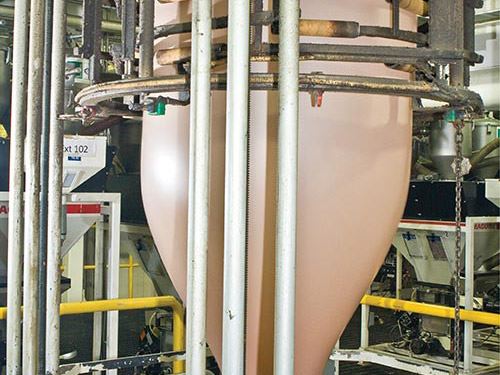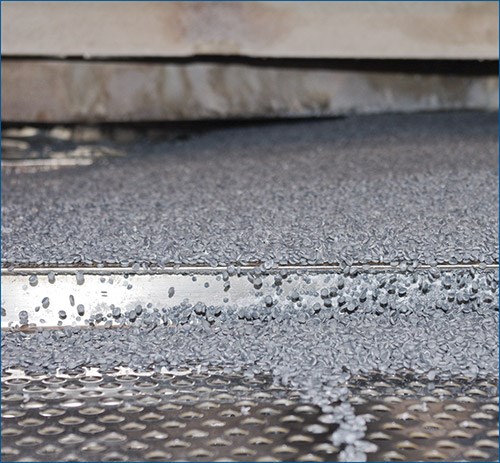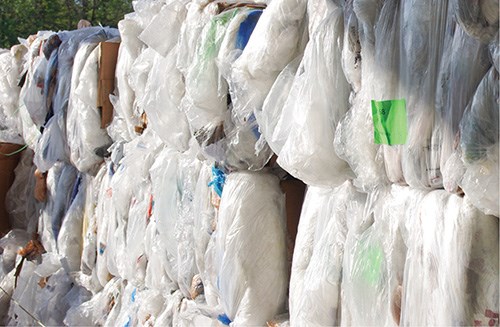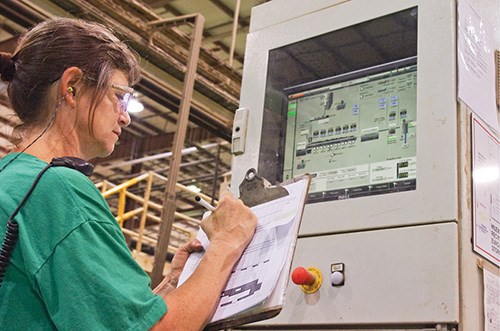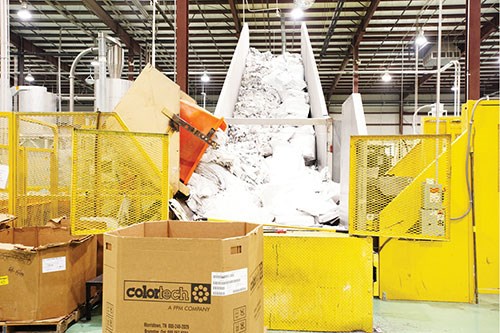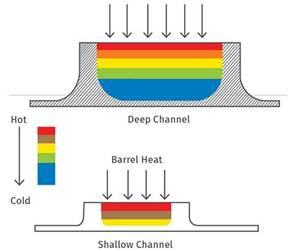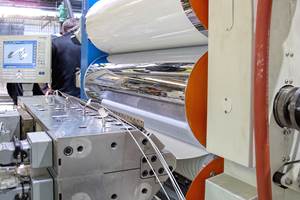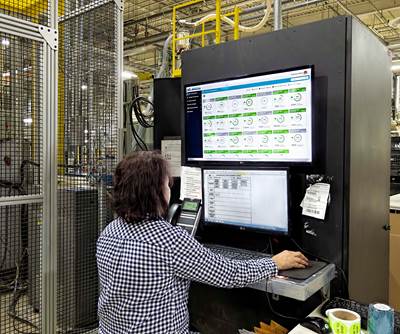Making Old Bags New Again
On Site: Hilex Poly
This year, leading film processor and bagmaker Hilex company reprocessed 25 million lb of post-consumer material in its Bag2Bag recycling program.
It wasn’t too long ago—maybe 25 years—that the polystyrene hamburger clamshell was cited by environmentalists as Public Enemy Number 1in the war against pollution. Now, certain environmental activists want to put the bull’s-eye on the plastic sack.
Bagmaking isn’t easy to begin with. Competition is fierce, product margins tend to be razor thin, and every now and then—depending mostly on the price of polyethylene—Chinese bag producers export their products here, making things even tougher for North American processors.
Throw into this mix environmental activism to ban plastic sacks because of their purported negative impact on the environment, and the market becomes even more challenging. There are currently no state-wide bans on sacks in effect, but each year more and more local governments take a swipe at it.
And some bag makers, resin companies, and trade associations are fighting back, not just with words but action. Look no further than Hilex Poly Co. LLC, headquartered in Hartsville, S.C., for Exhibit A in putting your money where your mouth is. In 2005, Hilex invested more than $20 million to launch the world’s first, and still largest, bag-to-bag recycling operation, in North Vernon, Ind. This film and bag maker calls the operation Bag2Bag, because it makes old bags new again.
Hilex started off modestly in 2005, collecting and reprocessing about 3 million lb of old sacks. In 2008, that number increased to 10 million lb. This year, states Mark Daniels, v.p. of sustainability and environmental policy, the company reprocessed 25 million lb of post-consumer material. Hilex augments its own reclaim efforts by buying film scrap from the outside.
The company has set up 30,000 collection bins in 45 states, located mostly at big-box retail outlets and major supermarket chains. Its primary partner in this project is retail-food giant Kroger. Bags and other film materials are collected, bailed, and brought to the retailer’s distribution center. Hilex takes over from there, shipping truckloads of bags to its recycling center in North Vernon.
Hilex was originally part of the High Density Film Products Div. of Sonoco Products Co. until 2003, when it bought out this segment of Sonoco’s business. Two years later, Hilex Poly purchased Vanguard Plastics, Inc. making it the largest retail carryout packaging manufacturer in the world.
Hilex currently makes primarily HDPE-based bags on several hundred blown film lines in nine plants throughout the U.S. Hilex is also a founding member of the American Progressive Bag Alliance, and spearheads an effort called Bag the Ban to quash legislative initiatives to ban plastic bags—or tax users of them—and to inform the general public about the facts of plastic bagmaking and recycling.
“Bans and taxes have the potential to destroy the plastic bag and film recycling infrastructure,” says Daniels. “Plastic bag and film recycling has gone up in the last 10 years. That is the most common-sense solution to the problem, not banning bags. We think we’re on the right path.”
In California, plastic bags account for just 0.3% of the waste stream, Daniels points out. And according to the 2010 Keep American Beautiful litter survey, bags were less than 1% of all litter nationwide.
WET OR DRY WASH, THEN EXTRUDE
The 100,000 ft² recycling facility in North Vernon employs more than 70 people. It processes up to 80,000 lb/day of post-consumer scrap. Bales are unloaded daily on an outdoor covered patio. The material then is “eyeball” checked to determine whether it needs to be dry- or wet-washed, explains Chris Dickson, operations manager of the recycling operation. Next, a bale-breaker chews up the material, and contaminants like metal strapping, paper labels, cans, and the like are removed by hand.
Hilex runs one wet and one dry washing system. Hilex utilizes a wet washing system from Sorema of Italy. The washing system is continuous and takes about 17 minutes, using mostly filtered and recirculated rain water, which is subsequently recycled.
The dry washing system includes a feeding and a cutting system furnished by Pierret, a Belgium-based company with a U.S. operation in Spartanburg, S.C..This system was modified extensively by Dickson and his group of engineers and fine-tuned for this particular application.
Plans are on the drawing board to add one more wet and two more dry washing lines. At the R&D stage is technology permitting HDPE milk jugs to be added to the recycling mix.
All material is then fed to a cascade extrusion line furnished by Erema, Ipswich, Mass. Operators take hourly samples of pelletized material to determine whether it is suited for blown film and bagmaking or whether further compounding is necessary.
In the latter case, the recycling plant is furnished with three 110-mm twin-screw compounders from KraussMaffei Berstorff, Florence, Ky., where the reclaim is pelletized using proprietary technology. Final pellets are conveyed to one of six silos after additional testing confirms their quality. These silos were recently equipped with special mixing paddles furnished by Universal Dynamics, Woodbridge, Va., to randomize the 200,000 lb of material they hold. From there, the material goes to Hilex’s eight film extrusion and bagmaking plants, including one adjacent to the recycling plant.
That plant houses more than 90 single-layer, narrow-tube blown film lines, mostly from Reifenhauser-Kiefel, Peabody, Mass., which produce film at thicknesses down to 14 microns. Hilex uses mezzanine-mounted oscillating winders to randomize gauge, along with home-grown process control and monitoring systems. Once master rolls are produced, they are printed and converted to bags off-line. The bags come in shades of gray, blue, tan, and yellow. Retailers historically have preferred white bags because they allow their own logos to pop, but the drive toward sustainability has convinced many to rethink that stance.
Hilex has an expression for this transition: “Gray is the new green.” The darker the bag, the higher the recycled content it contains. Says Daniels, “This is a powerful statement for us and supermarkets, retailers, and restaurants that use bags with recycled resin, because it shows how much we care about the environment.”
“It took us a couple of years of R&D to develop the process to produce a pellet that can combine LDPE, LLDPE, HDPE, and HMW-HDPE,” says Dickson. “There are seven ingredients that go into making a uniform pellet, and when you are running as thin and as fast as we are there isn’t much margin for error.” This year, the average Hilex bag contains 30% recycled material. Some go higher than 40%.
RECYCLING INITIATIVES GROW
Earlier this year, Hilex’s Bag2Bag program was recognized by the Flexible Packaging Association, a trade organization for film processors and converters, with its Flexible Packaging Achievement Award. “Our tremendous investment in recycling and sustainability has truly paid off, and we hope to make it even better in the future,” says Daniels. “Hilex Poly has proven our work is not only good for the environment, but good for business and jobs.”
Compared to conventional bags, Hilex bags with recycled content require less energy to produce, lower carbon emissions, divert millions of pounds from landfills each year, and provide sustainability-conscious consumers a carryout package with a closed-loop life cycle, states Daniels.
“One of the key elements to growing this recycling infrastructure is working with consumers and grocers to increase recycling each year. People are making the effort to bring their used bags and film wraps back to the store for recycling, and stores are working to educate consumers about the program. We are pleased that these efforts have resulted in an increase of 50% in plastic bag, sack, and wrap recycling in just the last five years, and we thank those consumers who participated in this tremendous growth.”
Daniels says one of the impediments to producing a bag with 100% post-consumer content is that 90% of consumers go beyond recycling and reuse their bags more than once—often, for example, as trash bags. But there are indications that bag recycling initiatives are on the way up. Moore Recycling Associates, Inc. reported early this year, on behalf of the American Chemistry Council (ACC) trade association, that wrap, bag ,and film recycling reached a record high of nearly 972 million lb in 2010. This represents an increase of more than 117 million lb, or 14%, over 2009, and a gain of 50% since 2005, when Moore Recycling began tracking this category.
ACC explains the uptick by a combination of increased access to collection points via grocery and retail chains, better labeling on bags, and a rise in consumer awareness. To continue building on the growth of film recycling, ACC recently formed a Flexible Film Recycling Group (FFRG). Its members represent the full plastics film value chain, from resin suppliers to film manufacturers, brand owners, and recyclers. Current members of FFRG include Avanguard, Dow Chemical, ExxonMobil, SC Johnson, Sealed Air, Wisconsin Film & Bag, and Trex.
This past April, Moore Recycling released another study reporting that more than 91% of the U.S. population can recycle their plastic bags locally, and nearly 75% recycle other types of flexible plastic wraps in their own communities. The study identified more than 15,000 drop-off locations that collect these items for recycling. The majority of collection centers are conveniently located in stores, frequently major grocery chains or retailers like Target and Lowe’s home-improvement stores.
The future of Hilex’s efforts—and of film recycling in general—depends a lot on consumers and their willingness to recycle and to suggest that retailers supply them with bags containing recycled materials. In a recent blog on the Hilex website, Daniels put it this way: “The more consumers recycle their plastic bags, sacks, and wraps, the more recycled content we can include in our new plastic bags. We have the technology to produce plastic bags with more recycled materials. While we know people reuse so many of their plastic bags that it limits recycling— increasing the recycling of other plastic sacks and wraps can make this possible.”
Related Content
How Polymer Melts in Single-Screw Extruders
Understanding how polymer melts in a single-screw extruder could help you optimize your screw design to eliminate defect-causing solid polymer fragments.
Read MoreThe Importance of Barrel Heat and Melt Temperature
Barrel temperature may impact melting in the case of very small extruders running very slowly. Otherwise, melting is mainly the result of shear heating of the polymer.
Read MoreHow to Effectively Reduce Costs with Smart Auxiliaries Technology
As drying, blending and conveying technologies grow more sophisticated, they offer processors great opportunities to reduce cost through better energy efficiency, smaller equipment footprints, reduced scrap and quicker changeovers. Increased throughput and better utilization of primary processing equipment and manpower are the results.
Read MoreRoll Cooling: Understand the Three Heat-Transfer Processes
Designing cooling rolls is complex, tedious and requires a lot of inputs. Getting it wrong may have a dramatic impact on productivity.
Read MoreRead Next
Lead the Conversation, Change the Conversation
Coverage of single-use plastics can be both misleading and demoralizing. Here are 10 tips for changing the perception of the plastics industry at your company and in your community.
Read MorePeople 4.0 – How to Get Buy-In from Your Staff for Industry 4.0 Systems
Implementing a production monitoring system as the foundation of a ‘smart factory’ is about integrating people with new technology as much as it is about integrating machines and computers. Here are tips from a company that has gone through the process.
Read More

